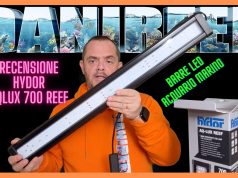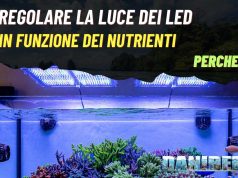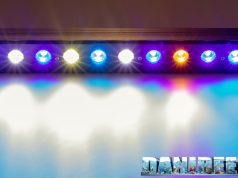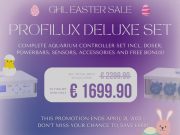How to value these numbers in aquarium?
This is a good question. At first we thought that we could transport these values to the aquarium tout-court. Than we filled the aquarium, insert the probe and redone the measurements. We fazed but, as we have already said in elsewhere, we’re going to talk about this in another article. Basically, while at 20 cm the result is practically the same, as we progressed, thanks to the glass and the water itself reflecting the light, we found even the double of the values measured in air. Obviously this isn’t a detail that can be standardized, so we think that our method of calculation is the most correct, and the best for the comparison of coverages of different ceiling lights.
Consumption
The measurement of the consumption was made possible thanks to the useful device RCE PM600 that can also measure the Cos(fi) (or power factor). The result is already given in watt.
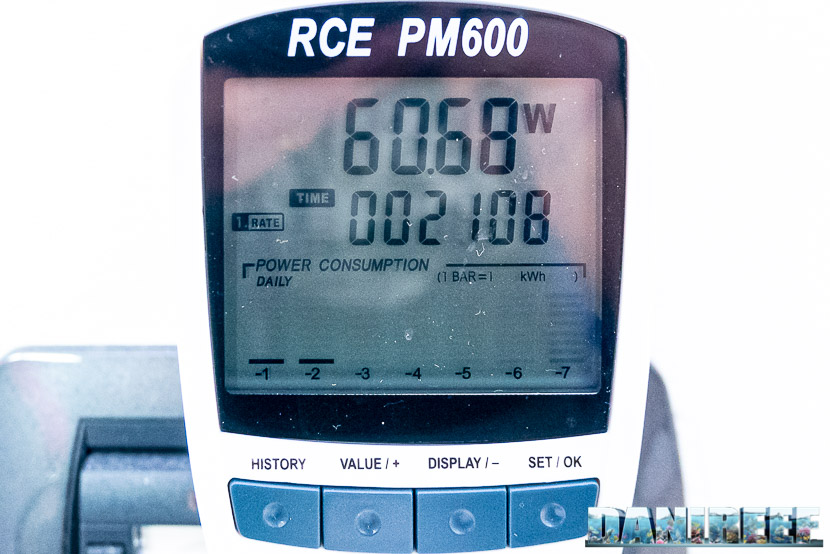
Here above there’s the maximum power and below the Cos(fi).
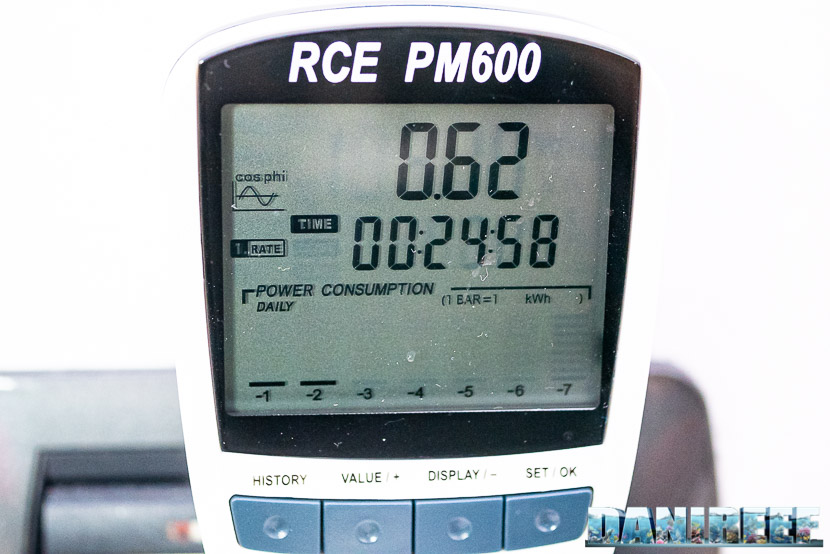
The calculus of the absorbed current, that is the power, is the following one:
Cetus 2 ceiling light: 60,68 watt. Considering that 17 cm the ceiling light has at the middle 746 μmol m-2 s-1, we can guess that it will have a peak value of 29,67 μmol m-2 s-1 w-1 (PAR per watt), higher than the Aqamai LRM which instead has 25,14 as you can read here.
The current consumption anyway is lower than declared, probably due to the vent system. But we are more interested in the PAR value rather than the similarity with the declared data, because we want to understand what this ceiling light allows us to breed.
The comparison with other ceiling lights on the market
Recently we started to use the new Apogee’s Quantum Meter MQ-510. For this we can’t completely compare the data of other ceiling lights because before we used the probe Seneye.
But considering the first celing lights we managed to test we can do an interesting comparison about their produced energy:
| Energy | Cost | Consumption | Energy/€ | Energy/w | |
| Aqamai LRM at 17 cm | 642.649 | 465 | 90,88 | 1.382 | 7.071 |
| Aqamai LRM at 37 cm | 721.676 | 465 | 90,88 | 1.552 | 7.941 |
| Aqamai LRM at 57 cm | 616.470 | 465 | 90,88 | 1.326 | 6.783 |
| Cetus 2 at 17 cm | 409.993 | 215 | 60,68 | 1.906 | 6.756 |
| Cetus 2 at 37 cm | 290.866 | 215 | 60,68 | 1.353 | 4.793 |
| Cetus 2 at 57 cm | 173.651 | 215 | 60,68 | 807 | 2.861 |
| Philips CoralCare at 17 cm | 1.858.572 | 749 | 190,50 | 2.481 | 9.756 |
| Philips CoralCare at 37 cm | 1.340.533 | 749 | 190,50 | 1.790 | 7.037 |
| Philips CoralCare at 57 cm | 933.246 | 749 | 190,50 | 1.246 | 4.899 |
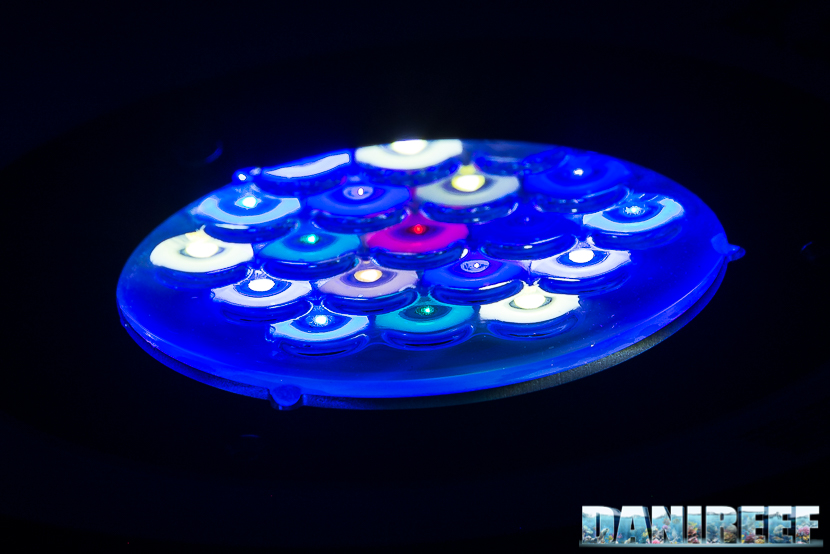
The energy per watt is similar to the Aqmai LRM, even if the latter have 50% more power. Then it decreases in line with the power and the cost. In fact the energetic value per euro is more convenient at 17 cm.
| Ceiling light | PAR | Watt | Prezzo | PAR/watt | euro per watt | euro per PAR |
| GNC 466 | 696 (Seneye) | 120 | 1.400 euro | 5,8 spread | 11,7 | 2,01 |
| Orphek Atlantik V4 | 1.515 (Apogee) | 226 | 1.099 euro | 6,7 spread | 4,9 | 0,73 |
| Philips CoralCare 2019 | 2.088 (Apogee) | 190 | 749 euro | 11 spread | 3,9 | 0,35 |
| Maxspect Ethereal | 689 (Seneye) | 130 | 500 euro | 5,3 semi-spread | 3,8 | 0,72 |
| Barra Led Askoll Pure Marine | 237 (Apogee) | 28 | n.d. | 8,4 | ||
| Zetlight UFO ZE-8000 | 791 (Seneye) | 91,5 | 500 euro | 8,6 cluster | 5,5 | 0,63 |
| Aqamai LRM | 2.285 (Apogee) | 90,88 | 465 euro | 25,14 double cluster | 5,1 | 0,20 |
| Cetus 2 | 746 (Apogee) | 60,68 | 215 | 12,29 cluster | 3,5 | 0,28 |
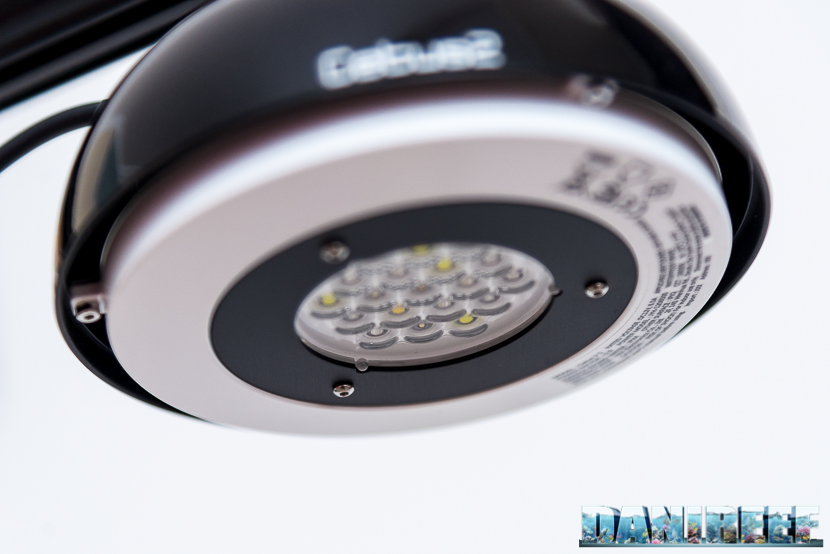
Devices in hand, the Cetus 2 has the euro per PAR value among the lowest in the category, so the efficency is at his maximum. In other words, it’s one of the most efficient ceiling lights, for its 215 euro is hard to ask more, plus watt and PAR are what they are, it can’t go over a certain level. And for your money it’s impossible to obtain more watt.
Mantaining costs
The Cetus 2 ceiling lights cost 215 euro.
The absorbed power is 60,68 watt, so the relationship cost/watt is about 3,5 euro per watt. In order to do a comparison with the other ceiling lights you can refer to this chart:
| Ceiling light | Price | Consumption | Relationship euro per watt | References |
| Cetus 2 | 215 euro | 60,68 watt | 3,5 euro per watt | DaniReef LAB |
| Philips Coralcare 2019 | 749 euro | 190 watt | 3,9 euro per watt | DaniReef LAB |
| Maxspect Ethereal | 500 euro | 126 watt | 4,0 euro per watt | Italian test |
| Radion XR30w G2 PRO | 790 euro | 170 watt | 4,7 euro per watt | Italian review |
| Radion XR30w G4 PRO | 915 euro | 190 watt | 4,8 euro per watt | Italian article |
| OceanLed Sunrise 600 | 870 euro | 180 watt | 4,8 euro per watt | Italian test |
| Orphek Atlantik V4 | 1099 euro | 226 watt | 4,9 euro per watt | Test |
| Radion XR30w G2 | 690 euro | 140 watt | 4,9 euro per watt | Italian review |
| Radion XR30w G4 | 760 euro | 150 watt | 5,1 euro per watt | Italian article |
| Aqamai LRM | 465 euro | 87,5 watt | 5,1 euro per watt | DaniReef LAB |
| Zetlight UFO ZE-8000 | 500 euro | 91,5 watt | 5,5 euro per watt | Test |
| CEAB Slide & Led | 2.700 euro | 275 watt | 9,8 euro per watt | Review |
| Sicce GNC 466 | 1.592 euro | 120 watt | 13,3 euro per watt | Italian review |
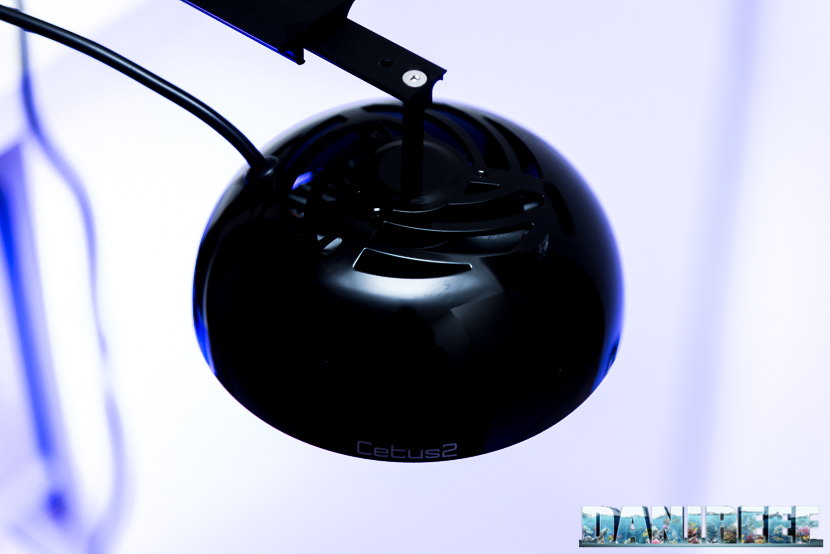
The ceiling light is very well built, small, but it seems very solid. Very easy to be set, and equipped with a very good software. Even though it has high efficiency, it’s difficult to obtain more PAR or watt with this money, at the end the values are perfect for nanoreef, especially for LPS and soft corals, and also for SPS like the montipora, at the top of the rock. The total expressed energy is very good, even if it can’t obviously compete with ceiling lights that cost and consume the double. What else do you need?
Questions and comments, as always, are welcomed. We also restored the comments by using Disqus, we hope they will work easily now.








